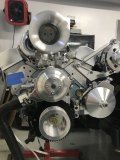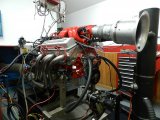NewbVetteGuy
Well-Known Member
I'm curious if there have been any good conversations here on benefits for air inlet bell mouths / velocity stack inlet shapes either ahead of a throttle body / above a carb, or on the entry to intake runners from a shared plenum.
This 4 page summary by Dr. Gordon Blair of his research on ideal bell mouth shapes is pretty accessable, IMO, but I haven't come across too many real-world tests nor a discussion on adding a bell mouth like this from a shared plenum to an intake runner entry. http://www.profblairandassociates.com/pdfs/RET_Bellmouth_Sept.pdf
-The CFD diagrams of different bell mouth profiles seems to show pretty clearly WHY / HOW they work.
In my oldish notes on this I noted that the "ideal" "elliptical bellmouth" shape that Blair says is ideal can increase airflow (and velocity) through a throttle body by 5.5% vs. just an open pipe but even a simple radiused entry like most of the available bell mouths you can buy increase airflow through a throttle body by 4.5%.
I bought this generic 4" to 7" velocity stack that attaches directly to my FIRST TPI intake perfectly for $30. My throttle body has a 71mm internal diameter and flows 835 CFM. Although throttle body sizing calculators tend to disagree a lot, I've found a recommendation for 78mm for a 350 @ 6,000 RPM even though they also say that a 350 @ 85% VE @ 6,000 RPM only needs 671 CFM. -If it does provide an extra 4.5% flow through the throttle body that's about +37.5 CFM and for $30 that seems great, if your engine is actually limited by throttle body flow at peak RPM (which I don't think mine is remotely close to that.).
-From the TPI flow testing that I've seen the velocity of the air through the throttle body -both with stock twin bore throttle bodies, and when replaced with a larger single throttle body the velocity is too high and a lot of the flow blows right past the entry to cylinder #1, so maybe more velocity through the throttle body is a bad thing on these and an over-sized throttle body that slows down the air so it can make the turn into #1 is better... Torn.
Note: This Bell mouth inlet was designed to be bolted to a turbo charger inlet, but bolts right up to a FIRST intake's throttle body: https://www.ebay.com/itm/231635856452
-My plan is to move the bell mouth to the inlet of my cold air intake when I get it all figured out. (Trying to make a C5 air bridge work on my C3 and have to get it low enough that it's out of the way of the hood.) I've found a huge 7" ID conical air filter that will work perfectly OVER the huge bell mouth.

Lots of great airflow testing videos and air bench results showing air just flying by cylinder #1 in a TPI: https://www.thirdgen.org/forums/tpi/779415-air-flow-tpi-plenum.html
I'm particularly interested in the importance of bell mouths / good radiused entries from a plenum and into a runner's entries. I remember in some old SpeedTalk discussions that bell mouths entries are just as good there and ideally they'd be up off the bottom of the floor.
I was reading "Practical Engine Airflow" by John Baechtel this weekend and he has a picture of some fabricated intakes that had the little screw-on bell mouths that kinda looked like donuts that were just screwed to the inside wall of a plenum and created a nice bell-mouth inlet shape where there wasn't one prior. He called them "Flowcaps". -I now can't find ANYTHING using that as a search term, but they DO seem like a really simple way to add a dramatically improved inlet from a plenum to an intake runner entry, although they would ever-so-slightly increase the effective runner length, I think.
-Has anyone ever seen these things or heard of them?
Yes, the Engine Masters carb-topper "Salad Bowl" is highly relevant to this discussion, although maybe not a Blair-esque "ideal" bell mouth. ;-)
This RCS Racing FIRST TPI crate engine appears like it might have at least two bell mouths stacked up in succession -ridiculous and impossible to ever run in a car, but it MIGHT just help make a couple more HP and have helped them hit their 460 HP / 520 ft lbs # with a stock FIRST on a 383.

Adam
This 4 page summary by Dr. Gordon Blair of his research on ideal bell mouth shapes is pretty accessable, IMO, but I haven't come across too many real-world tests nor a discussion on adding a bell mouth like this from a shared plenum to an intake runner entry. http://www.profblairandassociates.com/pdfs/RET_Bellmouth_Sept.pdf
-The CFD diagrams of different bell mouth profiles seems to show pretty clearly WHY / HOW they work.
In my oldish notes on this I noted that the "ideal" "elliptical bellmouth" shape that Blair says is ideal can increase airflow (and velocity) through a throttle body by 5.5% vs. just an open pipe but even a simple radiused entry like most of the available bell mouths you can buy increase airflow through a throttle body by 4.5%.
I bought this generic 4" to 7" velocity stack that attaches directly to my FIRST TPI intake perfectly for $30. My throttle body has a 71mm internal diameter and flows 835 CFM. Although throttle body sizing calculators tend to disagree a lot, I've found a recommendation for 78mm for a 350 @ 6,000 RPM even though they also say that a 350 @ 85% VE @ 6,000 RPM only needs 671 CFM. -If it does provide an extra 4.5% flow through the throttle body that's about +37.5 CFM and for $30 that seems great, if your engine is actually limited by throttle body flow at peak RPM (which I don't think mine is remotely close to that.).
-From the TPI flow testing that I've seen the velocity of the air through the throttle body -both with stock twin bore throttle bodies, and when replaced with a larger single throttle body the velocity is too high and a lot of the flow blows right past the entry to cylinder #1, so maybe more velocity through the throttle body is a bad thing on these and an over-sized throttle body that slows down the air so it can make the turn into #1 is better... Torn.
Note: This Bell mouth inlet was designed to be bolted to a turbo charger inlet, but bolts right up to a FIRST intake's throttle body: https://www.ebay.com/itm/231635856452
-My plan is to move the bell mouth to the inlet of my cold air intake when I get it all figured out. (Trying to make a C5 air bridge work on my C3 and have to get it low enough that it's out of the way of the hood.) I've found a huge 7" ID conical air filter that will work perfectly OVER the huge bell mouth.

Lots of great airflow testing videos and air bench results showing air just flying by cylinder #1 in a TPI: https://www.thirdgen.org/forums/tpi/779415-air-flow-tpi-plenum.html
I'm particularly interested in the importance of bell mouths / good radiused entries from a plenum and into a runner's entries. I remember in some old SpeedTalk discussions that bell mouths entries are just as good there and ideally they'd be up off the bottom of the floor.
I was reading "Practical Engine Airflow" by John Baechtel this weekend and he has a picture of some fabricated intakes that had the little screw-on bell mouths that kinda looked like donuts that were just screwed to the inside wall of a plenum and created a nice bell-mouth inlet shape where there wasn't one prior. He called them "Flowcaps". -I now can't find ANYTHING using that as a search term, but they DO seem like a really simple way to add a dramatically improved inlet from a plenum to an intake runner entry, although they would ever-so-slightly increase the effective runner length, I think.
-Has anyone ever seen these things or heard of them?
Yes, the Engine Masters carb-topper "Salad Bowl" is highly relevant to this discussion, although maybe not a Blair-esque "ideal" bell mouth. ;-)
This RCS Racing FIRST TPI crate engine appears like it might have at least two bell mouths stacked up in succession -ridiculous and impossible to ever run in a car, but it MIGHT just help make a couple more HP and have helped them hit their 460 HP / 520 ft lbs # with a stock FIRST on a 383.

Adam
